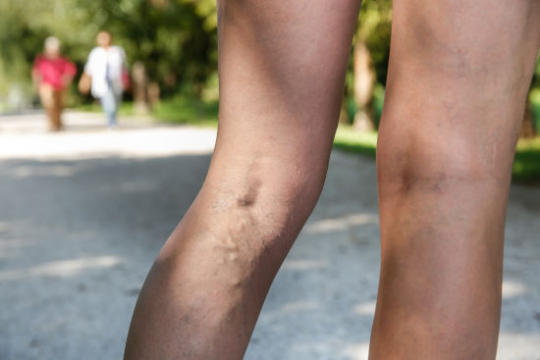Whether it is at home during the summer or on vacation in the winter, hot weather can be an uncomfortable time for people who have varicose veins. After all, shorts and bathing suits that come along with warm-weather wear don’t exactly mesh well with someone who may be feeling self-conscious about their legs. Beyond cosmetic concerns, the symptoms associated with varicose veins can be aggravated in the heat.
Varicose veins are twisted and enlarged veins that most commonly affect a person’s legs and feet, although any vein may become varicose. Your legs and feet are at higher risk because standing and walking increases the pressure in the veins of your lower body. Veins may be blue or dark purple in color and can be accompanied by aching legs or swollen ankles.
Varicose veins happen when the valves in your veins do not work properly and blood does not flow effectively through them. That can cause blood to collect and pressure to build.
“This pressure is what can create throbbing, cramping or swelling in the legs,” says Mark B. Kahn, M.D., a vascular surgeon at Crozer-Keystone Health System. “Most concerns surrounding varicose veins are cosmetic ones, but there are cases where skin ulcers can form near the veins, or blood can clot.”
If your leg suddenly swells or you’re experiencing serious throbbing or itching around one or more of your veins, you should see a doctor as soon as possible. Those symptoms may signal a more serious form of vascular disease.
Self-Care for Varicose Veins
“There are self-care measures that can be taken to treat symptoms of mild variations of varicose veins for those who are uncomfortable with the appearance of their legs,” says Kahn.
Beat the heat: This advice is good for everyone, not just those who have varicose veins. Keeping your body cool by wearing loose, breathable clothing can help ease symptoms, such as aching and tenderness. “Increased heat can cause veins to dilate and worsen common symptoms,” says Kahn. “Staying cool and hydrated can help improve your circulation and the appearance of your varicose veins.”
Elevate your feet: Elevating your feet when you are sitting can help relieve pressure in your veins. You can also put some pillows under your feet when you are lying down on a sofa or bed to encourage healthy circulation and decrease any leg swelling.
Keep it moving: Sitting and standing for long periods of time hurts circulation. If your job requires you to sit or stand in the same position for several hours, it’s important to do some simple stretches or activities throughout your day to improve circulation. It can be as simple as rotating your ankles, pointing your feet, or moving around the office every 20 minutes to counteract the effects of working in a sedentary environment.
“Sitting can cause blood and other fluid to pool in the legs, and standing can increase your risk for developing varicose veins,” says Kahn. If self-care treatment isn’t helping and you’re struggling with pain or discomfort, ask your doctor about treatment options. There are less invasive procedures that can often be performed on an outpatient basis.
About Crozer Keystone Staff
Crozer-Keystone Health System’s physicians, specialists and advanced practitioners are committed to improving the health of our community through patient-centered, quality care across a full continuum of health services. Crozer Brinton Lake is Crozer-Keystone’s comprehensive outpatient care facility in western Delaware County, offering primary care, specialty services, outpatient surgery and advanced cancer treatment. Contact us: 300 Evergreen Drive, Glen Mills, PA 19342 http://www.crozerkeystone.org/Brinton-Lake 1-855-254-7425
- Web |
- More Posts(131)


Comments